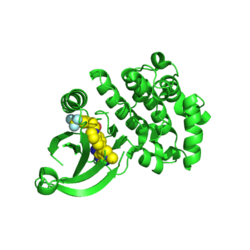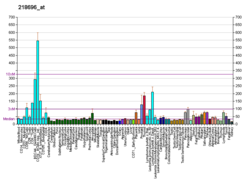EIF2AK3
EIF2AK3
Human protein and coding gene
Eukaryotic translation initiation factor 2-alpha kinase 3, also known as protein kinase R (PKR)-like endoplasmic reticulum kinase (PERK), is an enzyme that in humans is encoded by the EIF2AK3 gene.[5][6][7][8]
The protein encoded by this gene phosphorylates the alpha subunit of eukaryotic translation-initiation factor 2 (EIF2), leading to its inactivation, and thus to a rapid reduction of translational initiation and repression of global protein synthesis. It is a type I membrane protein located in the endoplasmic reticulum (ER), where it is induced by ER stress caused by malfolded proteins.[6]
Patients with mutations in this gene develop Wolcott-Rallison syndrome.[9]
EIF2AK3 has been shown to interact with DNAJC3,[10] NFE2L2,[11] and endoplasmic reticulum chaperone BiP (Hsp70).[12]
- GSK2606414
- 3-Fluoro-GSK2606414
- "Human PubMed Reference:". National Center for Biotechnology Information, U.S. National Library of Medicine.
- "Mouse PubMed Reference:". National Center for Biotechnology Information, U.S. National Library of Medicine.
- Shi Y, Vattem KM, Sood R, An J, Liang J, Stramm L, Wek RC (December 1998). "Identification and characterization of pancreatic eukaryotic initiation factor 2 alpha-subunit kinase, PEK, involved in translational control". Molecular and Cellular Biology. 18 (12): 7499–7509. doi:10.1128/MCB.18.12.7499. PMC 109330. PMID 9819435.
- Harding HP, Zhang Y, Ron D (January 1999). "Protein translation and folding are coupled by an endoplasmic-reticulum-resident kinase". Nature. 397 (6716): 271–274. Bibcode:1999Natur.397..271H. doi:10.1038/16729. PMID 9930704. S2CID 4416662.
- Yan W, Frank CL, Korth MJ, Sopher BL, Novoa I, Ron D, Katze MG (December 2002). "Control of PERK eIF2alpha kinase activity by the endoplasmic reticulum stress-induced molecular chaperone P58IPK". Proceedings of the National Academy of Sciences of the United States of America. 99 (25): 15920–15925. Bibcode:2002PNAS...9915920Y. doi:10.1073/pnas.252341799. PMC 138540. PMID 12446838.
- Cullinan SB, Zhang D, Hannink M, Arvisais E, Kaufman RJ, Diehl JA (October 2003). "Nrf2 is a direct PERK substrate and effector of PERK-dependent cell survival". Molecular and Cellular Biology. 23 (20): 7198–7209. doi:10.1128/MCB.23.20.7198-7209.2003. PMC 230321. PMID 14517290.
- Mellor H, Proud CG (July 1991). "A synthetic peptide substrate for initiation factor-2 kinases". Biochemical and Biophysical Research Communications. 178 (2): 430–437. doi:10.1016/0006-291X(91)90125-Q. PMID 1677563.
- Dever TE, Chen JJ, Barber GN, Cigan AM, Feng L, Donahue TF, et al. (May 1993). "Mammalian eukaryotic initiation factor 2 alpha kinases functionally substitute for GCN2 protein kinase in the GCN4 translational control mechanism of yeast". Proceedings of the National Academy of Sciences of the United States of America. 90 (10): 4616–4620. Bibcode:1993PNAS...90.4616D. doi:10.1073/pnas.90.10.4616. PMC 46563. PMID 8099443.
- Shi Y, Vattem KM, Sood R, An J, Liang J, Stramm L, Wek RC (December 1998). "Identification and characterization of pancreatic eukaryotic initiation factor 2 alpha-subunit kinase, PEK, involved in translational control". Molecular and Cellular Biology. 18 (12): 7499–7509. doi:10.1128/MCB.18.12.7499. PMC 109330. PMID 9819435.
- Sood R, Porter AC, Ma K, Quilliam LA, Wek RC (March 2000). "Pancreatic eukaryotic initiation factor-2alpha kinase (PEK) homologues in humans, Drosophila melanogaster and Caenorhabditis elegans that mediate translational control in response to endoplasmic reticulum stress". The Biochemical Journal. 346 (2): 281–293. doi:10.1042/0264-6021:3460281. PMC 1220852. PMID 10677345.
- Delépine M, Nicolino M, Barrett T, Golamaully M, Lathrop GM, Julier C (August 2000). "EIF2AK3, encoding translation initiation factor 2-alpha kinase 3, is mutated in patients with Wolcott-Rallison syndrome". Nature Genetics. 25 (4): 406–409. doi:10.1038/78085. PMID 10932183. S2CID 24521894.
- Saelens X, Kalai M, Vandenabeele P (November 2001). "Translation inhibition in apoptosis: caspase-dependent PKR activation and eIF2-alpha phosphorylation". The Journal of Biological Chemistry. 276 (45): 41620–41628. doi:10.1074/jbc.M103674200. PMID 11555640.
- Ma K, Vattem KM, Wek RC (May 2002). "Dimerization and release of molecular chaperone inhibition facilitate activation of eukaryotic initiation factor-2 kinase in response to endoplasmic reticulum stress". The Journal of Biological Chemistry. 277 (21): 18728–18735. doi:10.1074/jbc.M200903200. PMID 11907036.
- Okada T, Yoshida H, Akazawa R, Negishi M, Mori K (September 2002). "Distinct roles of activating transcription factor 6 (ATF6) and double-stranded RNA-activated protein kinase-like endoplasmic reticulum kinase (PERK) in transcription during the mammalian unfolded protein response". The Biochemical Journal. 366 (2): 585–594. doi:10.1042/BJ20020391. PMC 1222788. PMID 12014989.
- Biason-Lauber A, Lang-Muritano M, Vaccaro T, Schoenle EJ (July 2002). "Loss of kinase activity in a patient with Wolcott-Rallison syndrome caused by a novel mutation in the EIF2AK3 gene". Diabetes. 51 (7): 2301–2305. doi:10.2337/diabetes.51.7.2301. PMID 12086964.
- Koumenis C, Naczki C, Koritzinsky M, Rastani S, Diehl A, Sonenberg N, et al. (November 2002). "Regulation of protein synthesis by hypoxia via activation of the endoplasmic reticulum kinase PERK and phosphorylation of the translation initiation factor eIF2alpha". Molecular and Cellular Biology. 22 (21): 7405–7416. doi:10.1128/MCB.22.21.7405-7416.2002. PMC 135664. PMID 12370288.
- Marcu MG, Doyle M, Bertolotti A, Ron D, Hendershot L, Neckers L (December 2002). "Heat shock protein 90 modulates the unfolded protein response by stabilizing IRE1alpha". Molecular and Cellular Biology. 22 (24): 8506–8513. doi:10.1128/MCB.22.24.8506-8513.2002. PMC 139892. PMID 12446770.
- Yan W, Frank CL, Korth MJ, Sopher BL, Novoa I, Ron D, Katze MG (December 2002). "Control of PERK eIF2alpha kinase activity by the endoplasmic reticulum stress-induced molecular chaperone P58IPK". Proceedings of the National Academy of Sciences of the United States of America. 99 (25): 15920–15925. Bibcode:2002PNAS...9915920Y. doi:10.1073/pnas.252341799. PMC 138540. PMID 12446838.
- Pavio N, Romano PR, Graczyk TM, Feinstone SM, Taylor DR (March 2003). "Protein synthesis and endoplasmic reticulum stress can be modulated by the hepatitis C virus envelope protein E2 through the eukaryotic initiation factor 2alpha kinase PERK". Journal of Virology. 77 (6): 3578–3585. doi:10.1128/JVI.77.6.3578-3585.2003. PMC 149509. PMID 12610133.
- Cullinan SB, Zhang D, Hannink M, Arvisais E, Kaufman RJ, Diehl JA (October 2003). "Nrf2 is a direct PERK substrate and effector of PERK-dependent cell survival". Molecular and Cellular Biology. 23 (20): 7198–7209. doi:10.1128/MCB.23.20.7198-7209.2003. PMC 230321. PMID 14517290.
- Brandenberger R, Wei H, Zhang S, Lei S, Murage J, Fisk GJ, et al. (June 2004). "Transcriptome characterization elucidates signaling networks that control human ES cell growth and differentiation". Nature Biotechnology. 22 (6): 707–716. doi:10.1038/nbt971. PMID 15146197. S2CID 27764390.
- Senée V, Vattem KM, Delépine M, Rainbow LA, Haton C, Lecoq A, et al. (July 2004). "Wolcott-Rallison Syndrome: clinical, genetic, and functional study of EIF2AK3 mutations and suggestion of genetic heterogeneity". Diabetes. 53 (7): 1876–1883. doi:10.2337/diabetes.53.7.1876. PMID 15220213.
- Allotey RA, Mohan V, McDermott MF, Deepa R, Premalatha G, Hassan Z, et al. (December 2004). "The EIF2AK3 gene region and type I diabetes in subjects from South India". Genes and Immunity. 5 (8): 648–652. doi:10.1038/sj.gene.6364139. PMID 15483661. S2CID 21566833.
This article incorporates text from the United States National Library of Medicine, which is in the public domain.
This article on a gene on human chromosome 2 is a stub. You can help Wikipedia by expanding it. |





